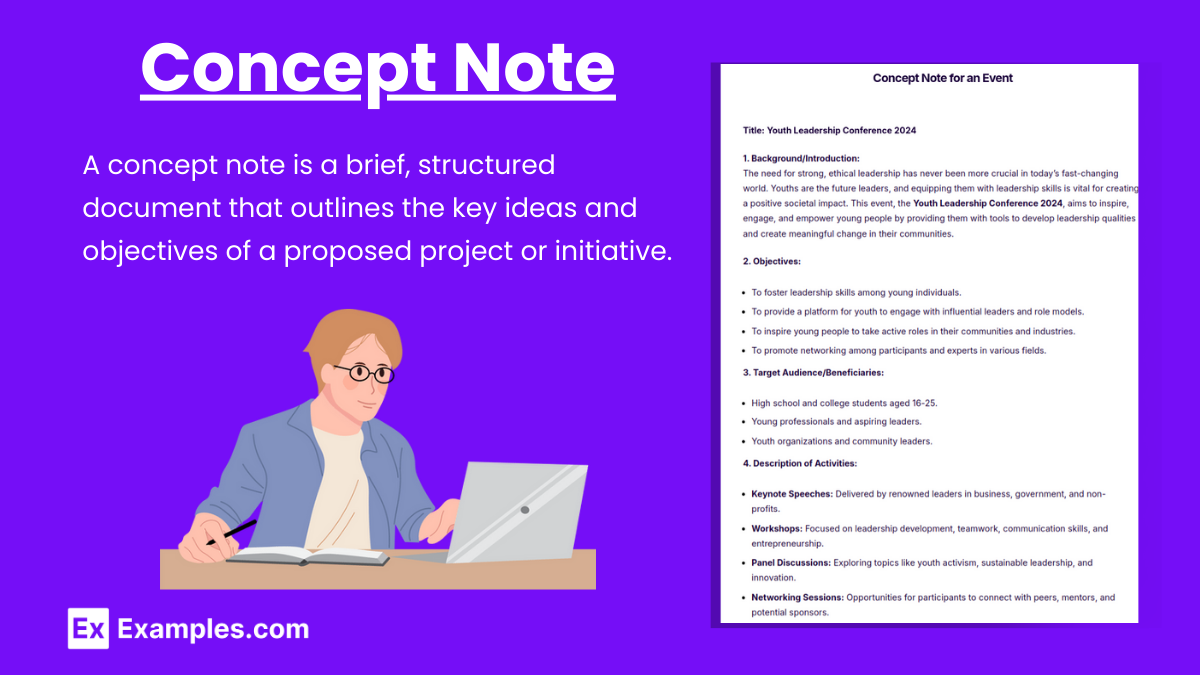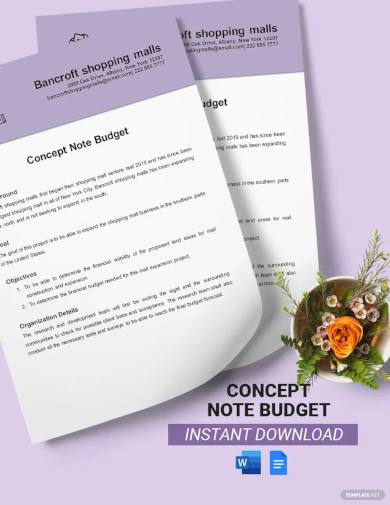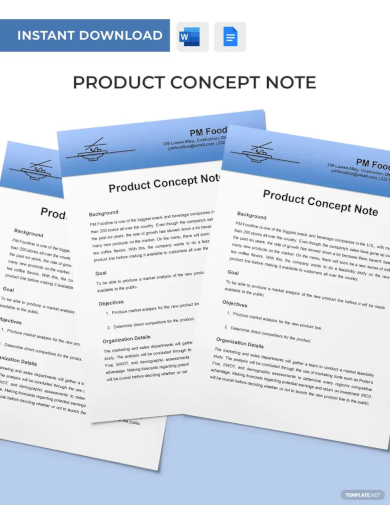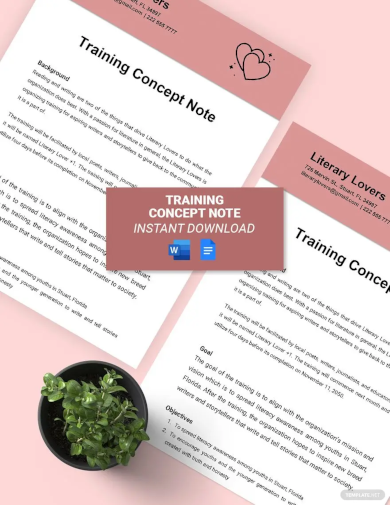20+ Concept Note Examples to Download
A concept note is a brief yet comprehensive document that outlines the key aspects of a project or proposal. It serves as an initial summary that highlights the problem being addressed, the objectives, methodology, and expected outcomes of the project. Concept notes are commonly used to pitch ideas to potential funders, stakeholders, or partners and are often the first step in seeking approval or financial support. By presenting a clear and concise overview, a concept note allows readers to quickly assess the viability and relevance of the project before committing to a more detailed proposal or full plan.
What is a Concept Note ?
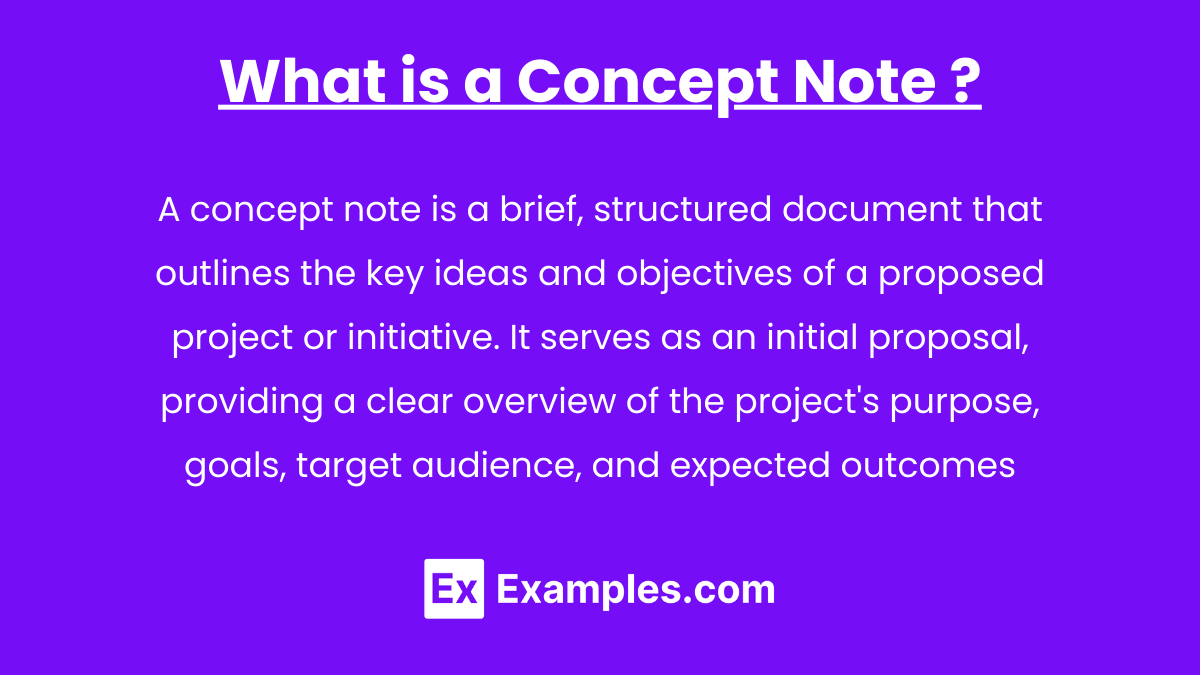
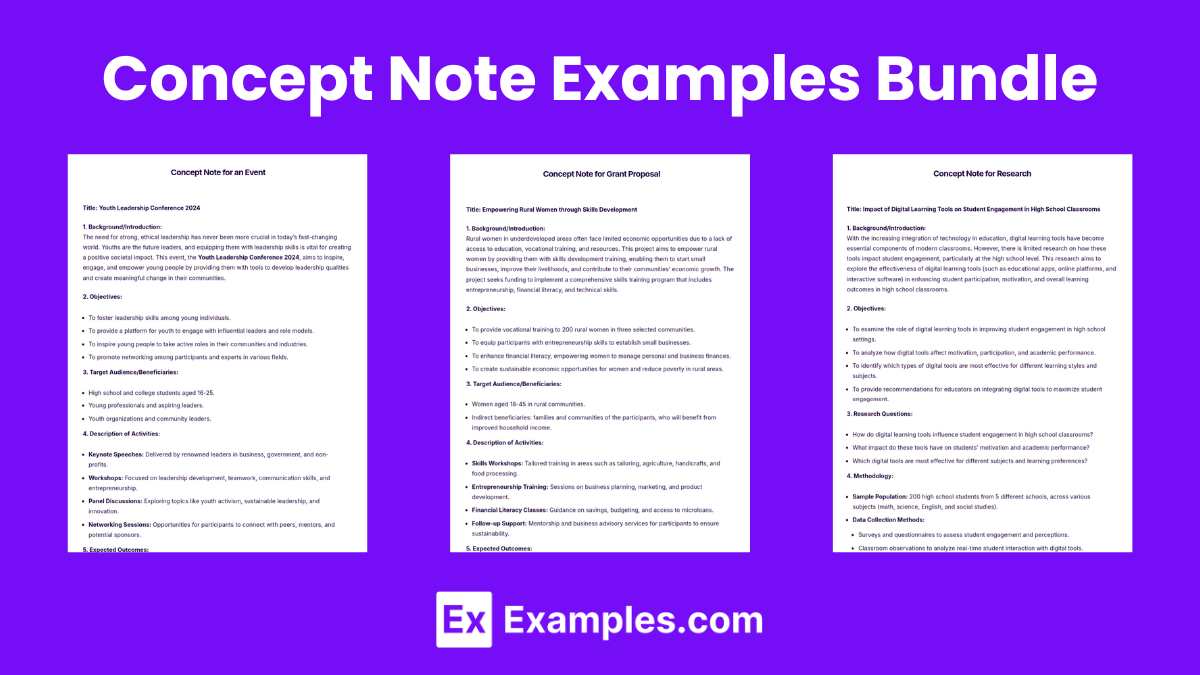
Download Concept Note Examples Bundle
Concept Note Format
A concept note is a concise document used to outline the basic idea of a project, event, or initiative. Below is a general format for a concept note:
Title of the Project/Activity/Event
Provide a clear and descriptive title that reflects the essence of the proposed project or initiative.
Background/Introduction
- Briefly explain the context or problem that the project seeks to address.
- Include any relevant background information, statistics, or reasons for the initiative.
Objectives
- List the main goals and specific objectives the project intends to achieve.
- Make these clear and measurable, if possible.
Target Audience/Beneficiaries
- Identify the primary audience or group who will benefit from the project.
- Define the scope (e.g., specific demographics, communities, or sectors).
Description of Activities
- Provide an outline of the main activities or events planned to achieve the objectives.
- Include details about the scope, duration, and implementation process.
Expected Outcomes
- Describe the anticipated results or impact of the project.
- Mention both short-term and long-term outcomes, where applicable.
Budget Estimate
- Offer a rough estimate of the cost required to execute the project or event.
- Breakdown of major expenses can also be included.
Timeline
- Provide a proposed schedule or timeline for the project’s major phases or activities.
- Mention any critical deadlines.
Partners/Stakeholders
- List any partners, collaborators, or stakeholders involved in the project.
- This can include organizations, sponsors, or key individuals.
Contact Information
- Provide the details of the primary contact person or organization responsible for the project.
Concept Note Example
Title:
Community Clean-Up InitiativeBackground/Introduction:
Environmental pollution has become a growing concern in our local communities. Improper waste disposal and lack of awareness about recycling have resulted in littering and environmental degradation. This project aims to engage the community in a clean-up drive, raising awareness and fostering a sense of responsibility for environmental preservation.
Objectives:
- To organize a community-wide clean-up event.
- To educate participants on waste management and recycling.
- To reduce litter and pollution in public spaces.
- To foster a sense of community responsibility for the environment.
Target Audience/Beneficiaries:
- Local residents, including families and schoolchildren.
- Community volunteers and environmental enthusiasts.
- Municipalities and local businesses.
Description of Activities:
- A one-day community clean-up event across key areas of the town.
- Workshops on waste segregation and recycling for volunteers and residents.
- Provision of cleaning tools, waste bins, and recycling stations at event locations.
- Post-event social media campaign to promote awareness and celebrate participation.
Expected Outcomes:
- Cleaner public spaces in the community.
- Increased awareness of environmental issues and responsible waste disposal.
- Establishment of recycling practices within the community.
- Stronger community engagement and collaboration for future environmental initiatives.
Budget Estimate:
- Cleaning supplies: $500
- Refreshments for volunteers: $300
- Promotional materials: $200
- Workshop materials and instructors: $400
- Total estimated budget: $1,400
Timeline:
- Planning and preparation: 2 weeks
- Event day: November 12, 2024
- Post-event promotion: 1 week
Partners/Stakeholders:
- Local schools and community centers.
- Environmental organizations and sponsors.
- Local businesses providing tools and refreshments.
Contact Information:
Project Lead: John Doe
Email: johndoe@example.com
Phone: (123) 456-7890
Concept Note for an Event
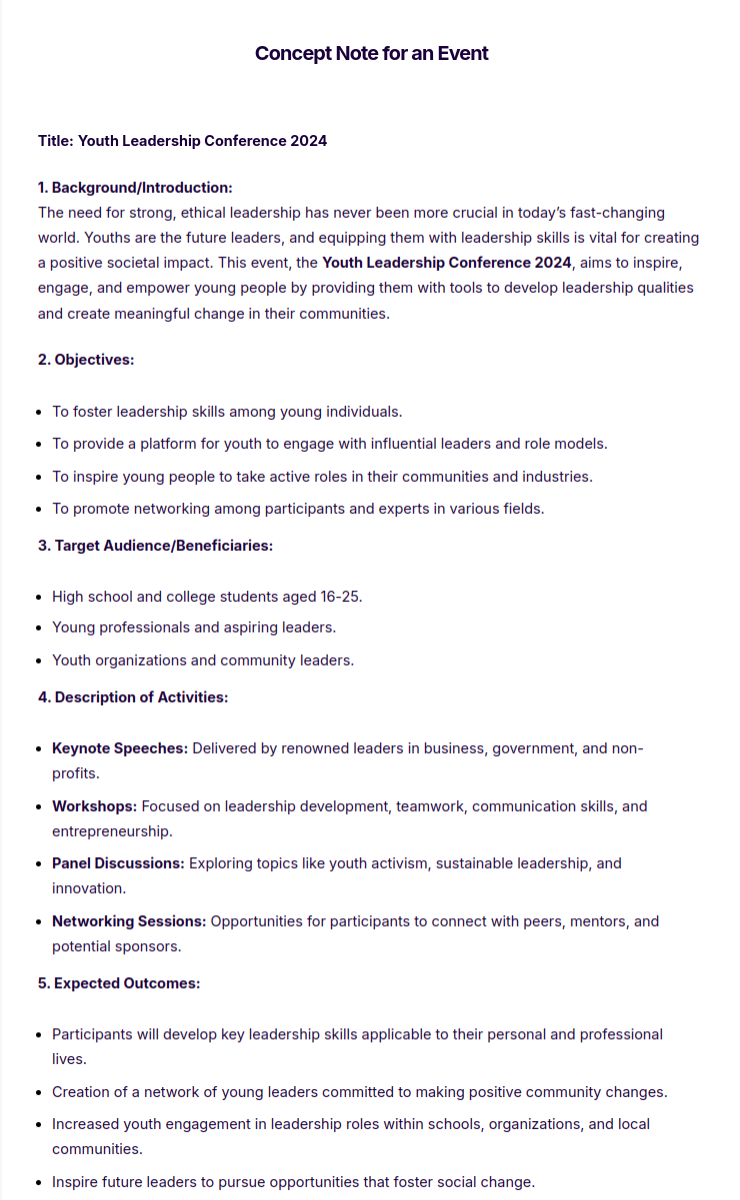
Concept Note for Grant Proposal
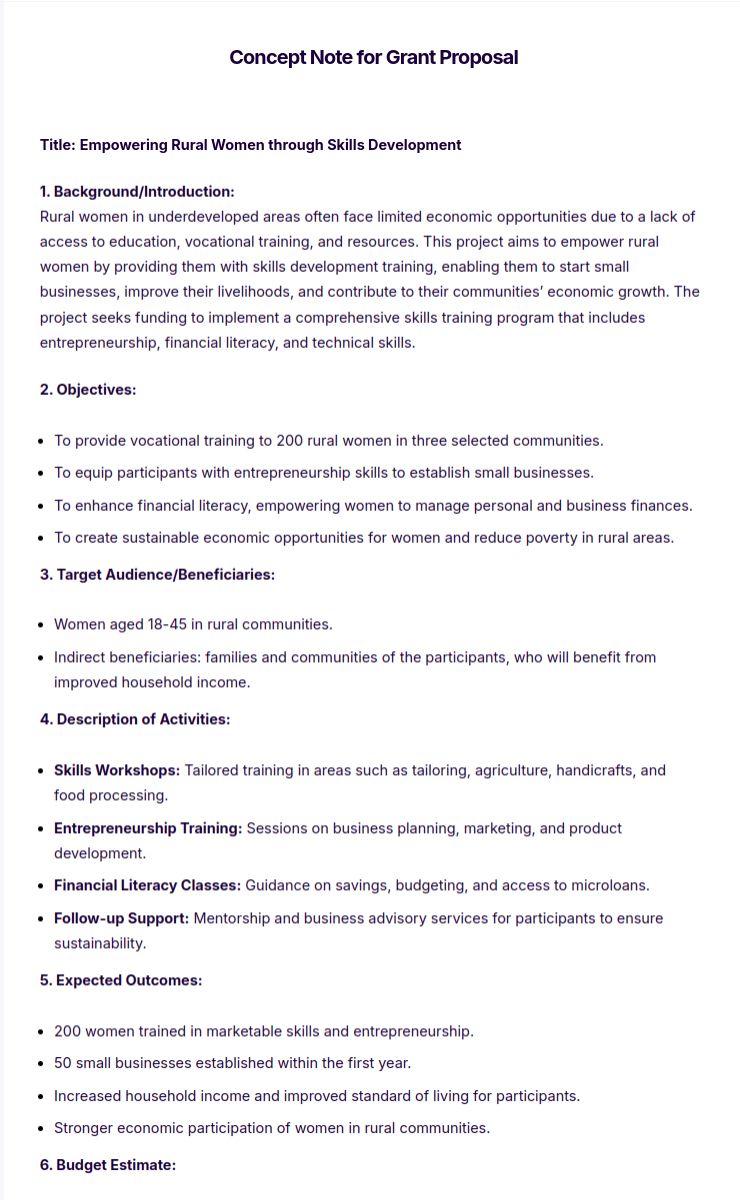
Concept Note for Research
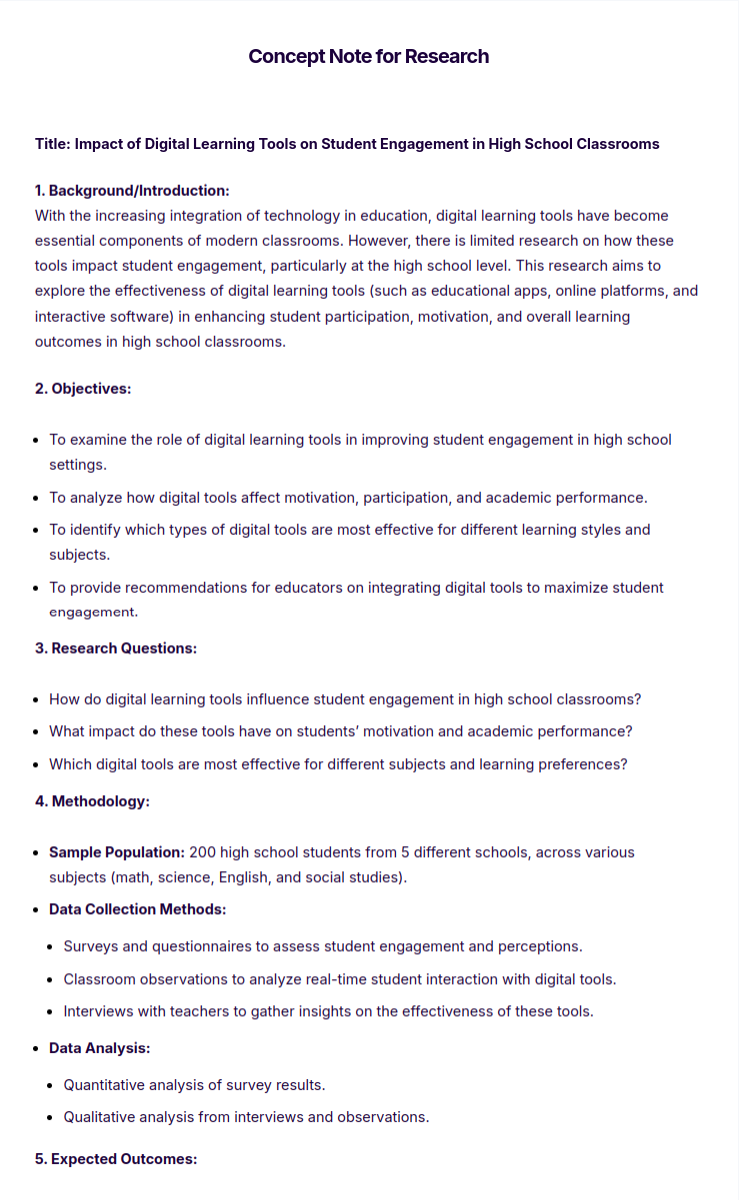
- Concept Note for Project
- Concept Note for Training Program
- Concept Note on Climate Change
- Concept Note on Capacity Building
- Concept Note on Tree Planting
- Concept Note on Mental Health
- Concept Note on Skill Development
- Concept Note on Poultry Farming
Concept Note Budget Template
Product Concept Note Template
Training Concept Note Template
Simple Concept Note Template
Draft Concept Note
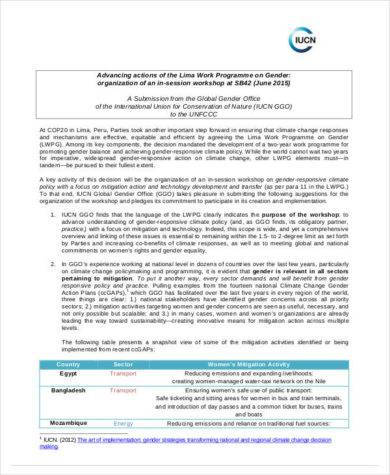
Concept Note on Vocationalization of Education
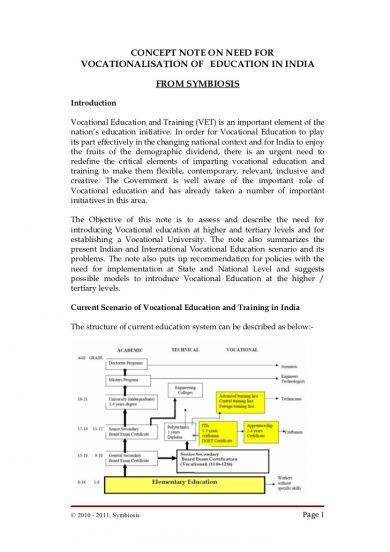
Design Concept Note Template
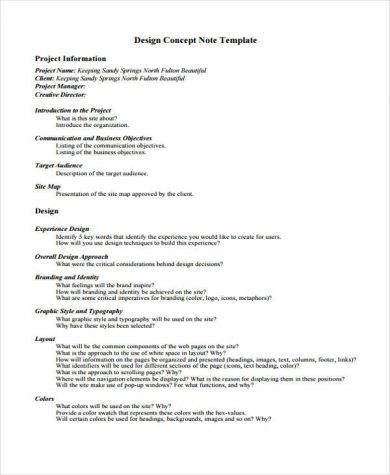
Concept Note for Training Workshops
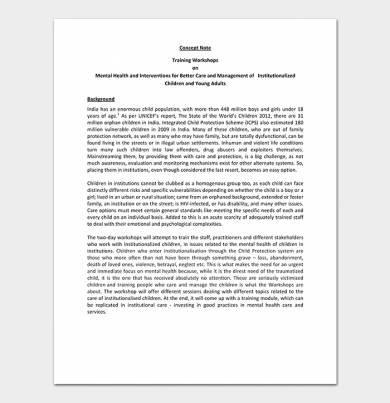
Activity Concept Note Example

What are the contents of the Concept Note?
- Title and Introduction:
- Clear project title and a brief introduction outlining the project’s purpose and context.
- Project Summary:
- Concise overview highlighting the project’s objectives, target beneficiaries, and anticipated outcomes.
- Problem Statement or Need Assessment:
- Description of the problem or need the project aims to address, including relevant statistics or data.
- Project Description:
- Detailed explanation of the project, its activities, methodologies, and innovative aspects.
- Target Audience or Beneficiaries:
- Identification and description of the beneficiaries or target audience and how they will benefit from the project.
- Expected Results and Impact:
- Clear articulation of the expected results, outcomes, and the project’s potential impact on the target group or community.
- Implementation Plan:
- Outline of the project’s implementation strategy, including timelines, resources required, and key milestones.
- Monitoring and Evaluation:
- Description of the methods, indicators, and tools to monitor progress and evaluate the project’s success.
- Sustainability and Exit Strategy:
- Plans detailing how the project will be sustained beyond the initial implementation phase and its potential for long-term impact.
- Budget and Financial Information: Overview of the budget, funding sources, and financial sustainability of the project.
Concept note vs Proposal
A concept note and a proposal are both important documents used in project development and fundraising, but they serve different purposes and vary in depth and detail. Here’s a breakdown of the key differences:
| Aspect | Concept Note | Proposal |
|---|---|---|
| Definition | A brief document outlining the basic idea of a project or initiative. | A detailed document that provides a comprehensive plan for implementing a project. |
| Purpose | Introduces a project idea to potential stakeholders or funders to gauge interest. | Formally requests funding or approval by providing a complete project plan. |
| Length | Typically 1-3 pages, concise and to the point. | Usually 10-20+ pages, depending on project complexity and funder requirements. |
| Content | Focuses on the core idea, objectives, and expected outcomes. | Includes detailed sections on the background, objectives, methodology, timeline, budget, and evaluation plans. |
| Level of Detail | High-level overview, with only key elements. | Comprehensive details about implementation, resources, and project management. |
| Audience | Initial communication with funders or stakeholders to assess interest. | Intended for decision-makers or funders who require a full project plan before committing resources. |
How to Write a Concept Note ?
Writing a concept note is an essential first step in outlining a project idea and securing interest from stakeholders or potential funders. Below is a step-by-step guide to writing an effective concept note:
Title of the Project
Choose a clear, concise, and descriptive title that reflects the core focus of the project.
Make the title engaging and relevant to the problem being addressed.Introduction/Background
Briefly describe the context or the problem your project aims to solve.
Use relevant statistics or research to emphasize the importance of addressing this issue.
State the project’s overall purpose and why it is necessary at this moment.Objectives
Clearly list the specific goals or outcomes you aim to achieve through the project.
Ensure the objectives are SMART (Specific, Measurable, Achievable, Relevant, Time-bound).Target Audience/Beneficiaries
Identify the primary group or community that will benefit from the project.
Be specific about the demographics (e.g., age group, geographic location, or particular industry).Project Description/Activities
Provide a brief summary of the key activities you will undertake to achieve the objectives.
Describe the how, outlining the steps or methods your project will use.
Mention any innovative approaches or tools involved.Expected Outcomes/Impact
Highlight the positive results or changes your project will bring to the beneficiaries or community.
Differentiate between short-term and long-term outcomes where applicable.
Be as concrete as possible, focusing on measurable impacts.Budget Estimate
Include a rough estimate of the overall cost of the project.
Break it down into major categories such as training, materials, staff, or equipment.
Keep the budget concise at this stage; you will provide more detailed figures in a full proposal.Timeline
Provide a general schedule for the project’s activities and implementation.
Outline the key phases of the project, including start and end dates.
Mention any critical deadlines or milestones you expect to reach.Partners/Stakeholders
Identify any key partners or stakeholders involved in the project (e.g., NGOs, government agencies, or community groups).
Mention any potential collaborations or external resources that will support the project’s success.Contact Information
Include the details of the primary contact person responsible for the project.
Provide email addresses, phone numbers, and any relevant organizational details.
Tips for Writing an Effective Concept Note
- Highlight innovation: If your project offers a novel solution or approach, make sure to emphasize it.
- Be concise: A concept note should be 1-3 pages long, focusing on the core aspects of your project.
- Use clear language: Avoid jargon and write in a simple, straightforward manner.
- Tailor to the audience: Understand the priorities of your target audience (e.g., funders, partners) and align the concept note with their interests.
- Focus on the Problem: Clearly define the problem your project addresses. Use data or examples to highlight its urgency and relevance. Ensure the problem resonates with the priorities of your target audience.
- Align with Funder Priorities: Research the goals and preferences of the potential funder or stakeholder. Ensure that your project aligns with their strategic focus, whether it’s education, health, or economic development.
FAQ’s
Why is a concept note important?
A concept note is important because it helps to communicate the essence of a project clearly and concisely. It allows potential funders or collaborators to quickly understand the project’s value, assess its feasibility, and decide whether to invest in or support its development. It also serves as a starting point for discussions before a detailed proposal is created.
What are the key components of a concept note?
The key components of a concept note typically include the title of the project, background or problem statement, objectives, methodology or approach, expected outcomes, and a brief budget overview. It may also include the target audience or beneficiaries, the project’s relevance, and timeline.
How long should a concept note be?
A concept note is usually brief, ranging from 1 to 3 pages. Its length depends on the complexity of the project and the requirements of the audience or funding agency. The idea is to present essential information in a concise and clear format.
How is a concept note different from a full proposal?
A concept note is a preliminary document that provides an overview of a project, while a full proposal is a detailed plan that includes comprehensive sections like project design, budget breakdown, and implementation strategies. The concept note is generally shorter and serves as a foundation for writing a more detailed proposal later on.
Can a concept note be revised after submission?
Yes, concept notes can often be revised after submission, especially if feedback is provided by funders or stakeholders. Revisions may include refining objectives, adjusting methodology, or providing more detailed budget information based on the input received.


